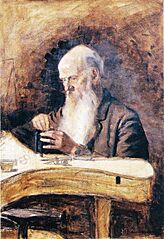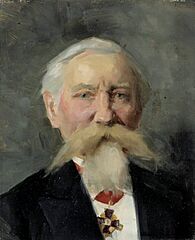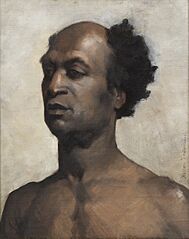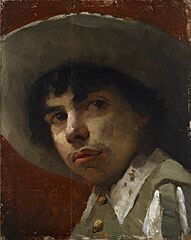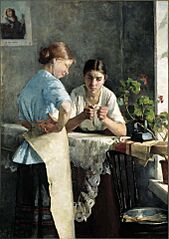Helena Westermarck facts for kids
Quick facts for kids
Helena Westermarck
|
|
|---|---|

Westermarck in 1894
|
|
| Born |
Helena Charlotta Westermarck
20 November 1857 |
| Died | 5 April 1938 (aged 80) Helsinki, Finland
|
| Nationality | Finnish |
| Known for | Painter, writer |
Helena Charlotta Westermarck (born November 20, 1857, in Helsinki; died April 5, 1938, in Helsinki) was a talented Finnish artist and writer. She spoke Swedish, which is common in Finland. Helena is especially known for writing important books about women's lives. She was one of the first to focus on this topic.
Contents
Helena's Early Life and Art Training
Helena Westermarck started her art journey at the Drawing School of the Finnish Art Society. She also studied at a private art school run by Adolf von Becker. During her studies, she became good friends with another artist named Helene Schjerfbeck. They remained close friends throughout their lives.
The "Painter Sisters" Group
Helena and Helene were part of a special group of female artists. They called themselves "the painter sisters." This group also included other talented artists like Maria Wiik and Elin Danielson-Gambogi. These women supported each other in their art careers.
Working in France
Helena Westermarck spent a lot of time working in France. She often traveled there with her friend Helene Schjerfbeck. Helena developed a realistic style in her paintings. She was especially good at painting portraits of people and scenes with figures.
At a big art show called the Exposition Universelle in 1889, she won an honorable mention. This was for her painting called Strykerskor.

Helena Becomes a Writer
In 1884, Helena got sick with tuberculosis. After this, she stopped painting and decided to focus on writing instead. She became a critic, writing about art and other topics.
Her First Novels
Helena began her writing career by creating novels. Her stories give us a peek into women's history. They show us what daily life was like for women from upper and middle-class families. She also helped edit a Swedish-language magazine for women called Nutid.
Research and Biographies
Helena Westermarck also became an important researcher. She wrote about culture and history. She even worked alongside her brother, Edvard Westermarck, at the British Library.
In the early 1890s, she started writing special biographies. These books told the life stories of many different women. She wrote about female painters who were not well-known at the time. Many of these artists, like Mathilda Rotkirch (whose biography she wrote in 1926), were "discovered" much later. Helena also wrote about women who were pioneers in their fields. These included Elisabeth Blomqvist (1916–17), Adelaide Ehrnrooth (1928), and Rosina Heikel (1930).
Helena Westermarck's own memories were published in a book in 1941.
Selected Works by Helena Westermarck
Helena Westermarck wrote many books and articles during her career. Here are some of her notable works:
- Ur studieboken I–II: Berättelser och utkast, 1890–91
- Framåt. Berättelse, 1894
- George Eliot och den engelska naturalistiska romanen. En litterär studie, 1894
- Nyländska folksagor berättade för ungdom af Helena Westermarck, 1897
- Lifvets seger, 1898
- "Tecken och minnesskrift från adertonhundratalet" I-III, 1900–1911:
- I I fru Ulrikas hem. Interiör från farmödrarnas tid, 1900
- II Ljud i natten. Berättelse, 1903
- III Vandrare. Roman, 1911
- Fredrika Runeberg. En litterär studie, 1904
- Dolda makter. Bilder och hägringar, 1905
- Bönhörelse. En historia, 1909
- Kvinnospår. Kulturbilder från 1800-talets förra del, 1913
- Elisabeth Blomqvist. Hennes Liv och gärning I–II, 1916–17
- Vägvisare. Berättelse, 1922
- Mathilda Rotkirch, Finlands första målarinna. En kulturbild, 1926
- Adelaïde Ehrnrooth. Kvinnospår i finländskt kulturliv, 1928
- Finlands första kvinnliga läkare Rosina Heikel, 1930
- Tre konstnärinnor. Fanny Churberg, Maria Wiik och Sigrid af Forselles, 1937
- Mina levnadsminnen, 1941
Gallery
See also
- Golden Age of Finnish Art
- Finnish art


